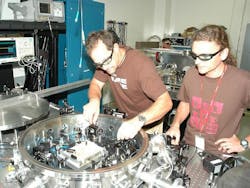JPL researchers demo noise-reducing time-delay interferometry for LISA spacecraft
Pasadena, CA--A team of scientists and engineers at NASA's Jet Propulsion Laboratory (JPL) has experimentally demonstrated that the noise (random frequency and phase fluctuations) in the laser setup for the proposed Laser Interferometer Space Antenna (LISA) spacecraft are low enough for LISA to work in space. If built and flown, LISA will attempt to directly detect gravitational waves for the first time.
"To detect gravitational waves, we have to make extremely precise measurements," said Bill Klipstein, a physicist at JPL. "Our lasers are much noisier than what we want to measure, so we have to remove that noise carefully to get a clear signal." Klipstein is a co-author of a paper about the lab tests that appeared in a recent issue of Physical Review Letters.
The technique, called time-delay interferometry (TDI), was tested in a lab setup designed to mimic the noise that would occur in LISA. Frequency noise was suppressed by about 109 and clock phase noise by about 6x104, reaching the noise floor of the lab setup.
The JPL team is one of many groups working on LISA, a joint European Space Agency and NASA mission proposal, which, if selected, would launch in 2020 or later. One of LISA's primary goals is to detect gravitational waves directly. LISA is expected to not only detect the waves, but also learn more about their sources--massive objects such as black holes and pulsars in the Milky Way galaxy as well as distant galaxies.
Inteference via software on the ground
The proposed mission places three spacecraft in a triangle with sides 5 x 106 km long. These spacecraft would fly in formation around the sun, about 20° behind Earth. Each one would hold a cube made of platinum and gold that floats freely in space. The relative positions of the cubes would be interferometrically monitored to an accuracy of about a picometer. On the spacecraft, the laser light is monitored by phase meters and the data sent to the ground, where it is "interfered" via data processing (which is why the process is called time-delay interferometry).
Other authors of the paper from JPL are Brent Ware; Kirk McKenzie; Robert E. Spero; and Daniel A. Shaddock, who has a joint post with JPL and the Australian National University in Canberra.
Subscribe now to Laser Focus World magazine; it's free!

John Wallace | Senior Technical Editor (1998-2022)
John Wallace was with Laser Focus World for nearly 25 years, retiring in late June 2022. He obtained a bachelor's degree in mechanical engineering and physics at Rutgers University and a master's in optical engineering at the University of Rochester. Before becoming an editor, John worked as an engineer at RCA, Exxon, Eastman Kodak, and GCA Corporation.
